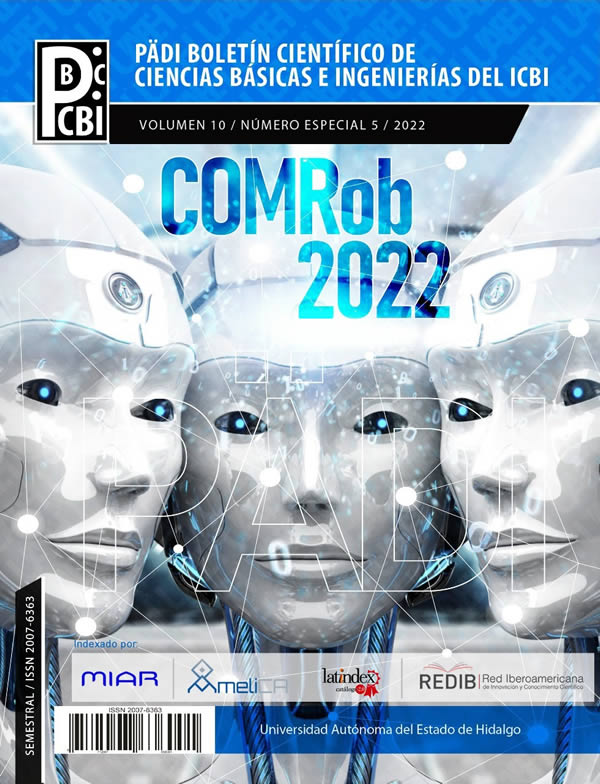Cinematica inversa basada en gradiente descendente cuaterniónico para cadenas ́
DOI:
https://doi.org/10.29057/icbi.v10iEspecial5.10206Palabras clave:
problema del camino más corto., interfaces hápticas,, manipuladores de robots, cinematica de robots, CuaternionesResumen
Se propone un algoritmo generalizado para encontrar la cinemática inversa de posición y velocidad de cadenas cinemáticas con articulaciones giratorias de n-DOF. Para ello, se utiliza la técnica del gradiente descendente, encontrando el ajuste cercano en sistemas redundantes utilizando la condición actual, con posibilidad de computar una nueva trayectoria con el propósito de evitar obstáculos. La validación numérica se realiza con dos cadenas cinemáticas, explicando de forma gráfica e intuitiva el método propuesto, de igual manera se presenta una validación experimental en tareas de guiado háptico local utilizando un dispositivo háptico de 3 DOF.
Descargas
Información de Publicación
Perfiles de revisores N/D
Declaraciones del autor
Indexado en
- Sociedad académica
- N/D
Citas
Aspragathos, N. A. y Dimitros, J. K. (1998). A comparative study of three methods for robot kinematics. IEEE Transactions on Systems, Man, and Cybernetics, Part B (Cybernetics), 28(2):135–145.
Bayro-Corrochano, E. (2010). Geometric computing: for wavelet transforms, robot vision, learning, control and action. Springer.
Bayro-Corrochano, E. y Kahler, D. (2000). Motor algebra approach for computing the kinematics of robot manipulators. Journal of Robotic Systems, 17(9):495–516.
Campa, R., Camarillo, K., y Arias, L. (2006). Kinematic modeling and control of robot manipulators via unit quaternions: Application to a spherical wrist.
En Proceedings of the 45th IEEE Conference on Decision and Control, pp. 6474–6479. IEEE.
Curry, H. B. (1944). The method of steepest descent for non-linear minimization problems. Quarterly of Applied Mathematics, 2(3):258–261.
Dominguez-Ramirez, OA, a. P.-V. V. (2003). Exploracion guiada remota háptica de objetos deformables. En Actas del Congreso y Exposición Internacional de Ingeniería Mecánica ASME 2003. Sistemas dinA¡micos y de control, volumen 1-2, pp. 793–800. DC, Ee.UU. 15-21 de noviembre de 2003.
Fuente, J., Santiago, J., Roman, A., Dumitrache, C., y Casasanto, D. (2014). ́
Handbook on robotics. Siciliano, editor, 25:1682–1690.
Goldman, R. (2010). Rethinking quaternions. Synthesis Lectures on Computer
Graphics and Animation, 4(1):1–157.
Hamilton, W. R. (1853). Lectures on Quaternions: Containing a Systematic Statement of a New Mathematical Method; of which the Principles Were Communicated in 1843 to the Royal Irish Academy; and which Has Since
Formed the Subject of Successive Courses of Lectures, Delivered in 1848 and Subsequent Years in the Halls of Trinity College, Dublin: With Numerous Illustrative Diagrams, and with Some Geometrical and Physical Applications. Hodges and Smith.
Hamilton, W. R. (1866). Elements of quaternions. London: Longmans, Green, & Company.
Hamming, R. (2012). Numerical methods for scientists and engineers. Courier Corporation.
Hart, J. C., Francis, G. K., y Kauffman, L. H. (1994). Visualizing quaternion rotation. ACM Transactions on Graphics (TOG), 13(3):256–276.
Huang, J., Wang, X., Liu, D., y Cui, Y. (2012). A new method for solving inverse kinematics of an industrial robot. En 2012 International Conferenceon Computer Science and Electronics Engineering, volumen 3, pp. 53–56. IEEE.
Jimenez, E. V. C., Navarro, D. A. O., Cort ́ es, M. A. D., y Enciso, J. V. O. (2016). Optimización: Algoritmos programados con MATLAB. Alpha Editorial.
Jones, T. M. (2005). AI Application Programming (Charles River Media Programming). Charles River Media, Inc.
Lechuga-Gutierrez, L., Medrano-Hermosillo, J., y Bayro-Corrochano, E. (2018). Quaternion spiking neural networks control for robotics. En 2018 IEEE Latin American Conference on Computational Intelligence (LA-CCI), pp. 1–6. IEEE.
Radavelli, L., Simoni, R., De Pieri, E., y Martins, D. (2012). A comparative study of the kinematics of robots manipulators by denavit-hartenberg and dual quaternion. Mec ́anica Computacional, 31(15):2833–2848.
Radavelli, L. A., Martins, D., De Pieri, E. R., y Simoni, R. (2015). Cinematica posicional de robos via iteracao e quaternios. ́Proceeding Series of the
Brazilian Society of Computational and Applied Mathematics, 3(1).
Shoemake, K. (1985). Animating rotation with quaternion curves. En Proceedings of the 12th annual conference on Computer graphics and interactive techniques, pp. 245–254.
Silva, A. J., Ramirez, O. A. D., Vega, V. P., y Oliver, J. P. O. (2009). Phantomomni haptic device: Kinematic and manipulability. En 2009 Electronics, Robotics and Automotive Mechanics Conference (CERMA), pp. 193–198. IEEE.
Spong, M. W., Hutchinson, S., y Vidyasagar, M. (2020). Robot modeling and control. John Wiley & Sons.
Turijan-Rivera, J., Machorro-Fernandez, F., Ruiz-Sanchez, F., Parra-Vega, V., y Dominguez-Ramirez, O. (2013a). Nasa-tlx assessment of modern close loop controllers in haptic guidance for assisted rehabilitation. En Converging Clinical and Engineering Research on Neurorehabilitation, pp. 243–247. Springer.
Turijan-Rivera, J. A., Ruiz-Sanchez, F. J., Domínguez-Ramirez, O. A., y Parra-Vega, V. (2013b). Plataforma modular para la orientacion h ́ aptica en rehabilitacion pediátrica de discapacidades neuromusculares de las extremidades superiores. En Converging Clinical and Engineering Research on Neurorehabilitation. Biosistemas y Biorobotic, volumen 1, pp. 1–30. Springer, Berlín.
Vince, J. y Vince, J. A. (2010). Mathematics for computer graphics, volumen 3. Springer.
Yang, X., Wu, H., Li, Y., Kang, S., y Chen, B. (2019). Computationally efficient inverse dynamics of a class of six-dof parallel robots: Dual quaternion approach. Journal of Intelligent & Robotic Systems, 94(1):101–113.
Yu, P., Xia, K., y Li, J. (2011). A design of reconfigurable satellite control system with reaction wheels based on error quaternion model. En 2011 International conference on internet computing and information services, pp. 215–218. IEEE.
Zhang, J., Xu, W.-f., y Meng, D.-s. (2013). Inverse kinematics resolution method of redundant space manipulator based on arm angle parameterization.
En Proceedings of the 32nd Chinese Control Conference, pp. 6022–6027. IEEE. Zhang, X., Xiu, C., y Wang, X. (2018). 2018 chinese control and decision conference (ccdc).




















